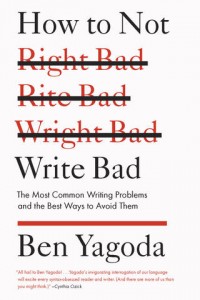My financial writing crusade
“Are you on a crusade?” A reader asked me that question with a smile after he read the Barron’s article that quoted me on the need for financial writers to lower the grade level of their writing.
If you’re a regular reader of this blog, you’ll probably say the answer is “Yes, I am on a financial writing crusade.” After all, I often urge people to improve their financial writing. Plus, I put the term in the title of this post, picking up on the wording of my reader’s question.
However, I prefer to think of myself as an advocate for good writing. The word “crusade” has overtones of intolerance and single-mindedness. I don’t want to demean people who are doing their best to communicate. Indeed, sometimes poor writing can be good enough for the situation. Think, for example, about a condolence card. The sincere expression of sympathy is more important than the worst misspellings and awkward wording.
Still, good financial writing beats bad financial writing. It’s important because good financial writing helps people to understand the world of earning, spending, saving, and investing. It might even make the difference between an individual sleeping peacefully instead of tossing and turning at night, due to worries over an investment. It might prevent litigation when risks are clearly disclosed by a disclosure document. On a less dramatic note, it might help institutional investors to choose the strategy that’s right for their unique circumstances.
Here’s what I believe about good financial writing.
Everyone can learn to write better
Good writers are made, not born. You’ll benefit from having other people read and edit your work. Classes, reading and analyzing other people’s work, and using software tools also help.
I think of myself as a good writer, but I still have room for improvement. I continue to read and get feedback from others to enhance my writing.
I’ve come a long way. I mention this to make you realize that you also can improve. As I said in an earlier post, “I wince when I read selections from my Ph.D. thesis, Bureaucracy and Politics in the 1930s: The Career of Goto Fumio.” It’s full of the kind of writing that I warn people against today. My path to improvement involved taking many writing classes, participating in writing groups, and being edited by savvy editors.
I’ve been thrilled to see some of the hard-working students in my financial blogging class make big improvements in their writing. Even small improvements can help. For example, if your sentences average 32 words in length, cutting the average length to 22 words will boost your readability.
You’ll benefit from becoming aware of your writing grade level
To improve your writing, you need to learn your weaknesses. One of the biggest weaknesses of much financial writing is that it’s too long-winded. The authors use too many multisyllabic words in long, convoluted sentences that pile one upon another in impenetrable paragraphs.
To get an idea of how you rate in terms of long-windedness, look at your grade level, which I discussed in “Donald Trump, grade level, and your financial writing” and “Free help for wordy writers!” Grade level calculations reflect the average length of your words and sentences.
However, don’t use grade level as the only measure of your work’s quality. Sometimes longer sentences are clearer than short sentences.
Different grade levels and vocabulary work for different audiences
The grade level and vocabulary that you can get away with depends on your audience.
Imagine that you’re a fixed-income strategist writing to your team about a change in your strategy. Using technical terms such as “duration” and “convexity” is perfect for your audience of investment professionals. These concisely convey your meaning in an exchange between professionals. You can also get away with writing long because your readers, as your employees, are highly motivated to read what you write. If they don’t grasp it, they can’t do their jobs.
Now, imagine that you need to communicate the strategy to an audience of unsophisticated individual investors. If you don’t delete the technical terms—or explain them in plain language—you’ll lose your readers. They won’t have a clue what you’re talking about. Plus, they may not care about the fine points of your strategy. Unlike your professional colleagues, they’re not motivated to stick with you.
In general, I believe institutional investors and other financial professionals crave more details than the individuals in your audience. Still, they’ll appreciate it when you streamline your writing, even when they approve of your using technical terms. Better writing benefits everybody.
Learning how to organize your thoughts before you write will help
Many professionals struggle to write. It takes them a long time to draft and edit their writing.
I’d like you to suffer less through the writing process. Organizing your thoughts before you write will help. One of the inspirations for my book, Financial Blogging: How to Write Powerful Posts That Attract Clients, was my desire to describe a step-by-step process for writing that includes organizing your thoughts before you write.
When you know what you want to say and you organize your thoughts before you write, you’ll write faster and more clearly. When you use a repeatable process tailored to your needs, your stress declines even more. This is part of what I teach in my financial blogging class.
Don’t let legal and compliance feedback ruin your writing
I know some great people who work in the legal and compliance areas for registered investment advisors, registered representatives, and other financial organizations. However, as one of my old bosses told me, “Legal never gets in trouble for saying ‘No.’ ”
Learn enough about legal and compliance requirements so you can push back when necessary. Sometimes your legal or compliance experts make changes that are a matter of their style preferences—not legal or regulatory requirements. In addition, the jargon used by some legal and compliance experts can inspire the confusion and litigation that they’re trying to avoid, as I discussed in “Ammo for your plain-language battle with compliance.”
People who write badly aren’t bad or stupid people
There’s no need to shame people who write badly. They aren’t bad people. Nor are they stupid. They simply haven’t been educated yet. Or perhaps they don’t have an aptitude for writing. We all have different strengths.
If you follow me on social media, you have seen my Mistake Monday posts, in which I invite readers to test their proofreading skills by finding typos and other errors in writing samples. I don’t call those people stupid. I can’t. That’s because I’ve posted many of my own errors on Mistake Monday.
It’s hard for us to catch our own errors. If you want to catch more of your errors, here’s one of my best proofreading tips.
Let’s show compassion to the people who don’t write as well as we do.
What do you believe about good writing?
I’d like to hear from you. Tell me what you believe about good financial writing.
Image courtesy of The British Library/flickr


